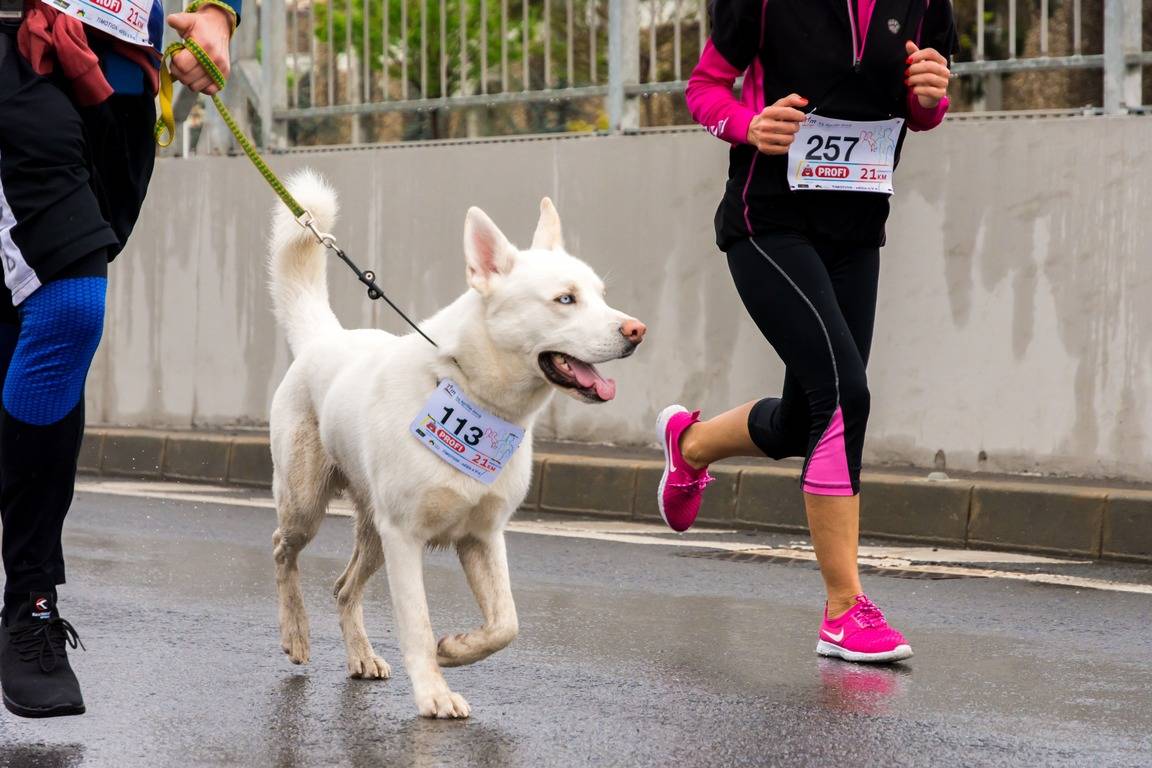According to the Whole Dog Journal, jogging with dogs improves overall fitness and health. This may be one of the reasons why many runners adore training with their pets.
Did you know that runner’s high is not just a human prerogative? According to research, dogs feel the same euphoria from running workouts. Still, it doesn’t mean that you can train a dog to run with you no efforts – there are a lot of rules you should follow to make the workout an amazing experience for your pet and prevent injury.
In this article, we gathered the main tips and answers to the most common questions about how to start running with your dog to save you time searching for all the information.
How Far Can a Dog Run?
This is a very common question that worries a lot of runners. It depends on many factors, including age, energy, athletic qualities, and, of course, the breed. Some dogs can run up to 25 to 35 miles (56.33 km) weekly with proper training and conditioning.
If you don’t have a four-footed friend yet but are considering getting one and training a dog to run with you, think carefully when choosing the breed.
The best dog breeds for running include:
- Weimaraner;
- Pointers – German and English;
- Hungarian Vizsla;
- Jack Russell Terrier;
- Fox Terrier;
- Retrievers: Labrador, Golden, Chesapeake, Curly and Flat coat;
- Rhodesian Ridgeback;
- Shepherds: German, Belgian, Australian;
- Cattle dogs: Blue Heeler, Kelpie;
- Border Collie and Rough Collie;
- Husky;
- Standard Poodle.
As you can see, we mentioned even small breeds, like terriers – they are perfectly suitable for running workouts.
What if I Want a Partner for Long-Distance Running?
Hunting and herding breeds like German Short-haired pointers, Jack Russells, Border Collies, and Kelpies tend to suit long distances (over 10K), while such breeds as Greyhounds, Pitbulls, and Golden Retrievers are well-suited for middle distances (less than 10K). So, consider these breeds if you want to run more than 5K with a dog.
Breeds unsuitable for dog running include brachycephalic ones like the English Bulldog, French Bulldog, and Pug. In addition, it is not recommended to use giant breeds like gentle Saint Bernards and Newfoundlands or dogs with heavy muscular builds like Mastiff-type breeds.
Puppies on the Run
Some vets say that you shouldn’t start running and even walking for long distances with puppies before they grow up enough (from 1 year) – their muscles and bones should have fully matured. Otherwise, you risk injuring your pet.
Still, each dog owner knows that physical activity is important for their pet. But what is the right amount?
According to the American Kennel Club, you should begin with a visit to your veterinarian – they can recommend when to start running with a puppy. Afterward, you can talk to your breeder – they might know the approximate age you can start to run with your puppy.
ACK also provides exercise safety tips, which you should follow regardless of your dog’s age, to keep your puppy safe during exercise:
- The first thing you should do is teach your puppy how to walk on a leash.
- Start with short walks with frequent breaks.
- Gradually increasing the length of the walk is essential.
- You should avoid walking with your puppy during the hottest and coldest parts of the day.
- Always walk on safe footing, avoiding slippery or sharp surfaces.
- If your puppy shows any signs of lameness, immediately call your vet.
What Prevents Running with a Dog?
There are some reasons which make running workouts forbidden for your pet. These can be health issues such as:
- Obesity;
- Arthritis;
- Age;
- Hip Dysplasia.
To prevent unforeseen circumstances, go for regular health check-ups with your veterinarian. As a rule, only start running if you are sure your dog is healthy.
How to Train Your Dog to Run with You?
Before teaching your dog to run with you, help your pet to master loose-leash walking. It is essential, as a companion that pulls on the leash is dangerous at high speeds. To train your dog not to tug the leash, use rewards. It may be praise, treats, or toys.
It is also essential to keep your dog on the one side. It doesn’t matter what side you choose – it should be the same each time. This will prevent you from tangling your legs on the leash or your/your dog from falling.
Start teaching from walking and only then start running. Do not forget about the reward each time.
Combining this advice and tips from the list below, you will teach your pet and have great workouts together!
How to Start Running with Your Dog? Main Tips
Before starting running workouts with your dog, be sure that you have taken into account all the details we mentioned below.
1. Breed
Be sure that your dog’s breed is suitable for running. Consult with your veterinarian and breeder to know your pet’s specifics. If all is ok, move to the next point of the list.
2. Age
We have discussed the issue of running with puppies and why it is forbidden – they can get injured. You may ask yourself “When can I run with my pet safely?” The common answer is from 12 to 18 months. Still, your dog must be old enough but not too old. Senior dogs might be fragile and in bad shape for intensive running workouts. You should reduce the load if your pet is older than 7 or 8 years for large dogs, 10 years for medium-sized ones, and 11-12 years for small breeds (senior citizen age, according to VCA). Of course, your vet can also tell you if your dog’s age is ok for running.
3. Training Level
If you wonder how to teach your dog to run with you, start with some basic commands. Once your dog knows them and is ready to run on the side, not pulling the leash, it is time to work on the speed, comfortable for both of you. Bryan Barrera, the founder of D.C. Dog Runner and the author of The Ultimate Guide to Running with Your Dog, says that you’ll have to lean into the type of running that fits your dog, which will make the run much more enjoyable for you both.
4. Make Sure You Have Proper Gear for the Run
- Leash. Bryan Barrera recommends a 4-foot leash and avoiding using a retractable leash, as it can cause injury.
- Harness. It must be well-fitting and comfortable. This gear is handy if you have a dog who likes to pull a lot or has a sensitive/thin neck.
- Water. You are responsible for keeping your pet hydrated, as it cannot ask you for a glass of water. Buy a special bottle and a collapsible bowl to give your dog water. Pay attention to the signs of dehydration, which may include a dry nose, excessive panting, dry-looking eyes, etc.
- Poop Bags. Yes, sometimes nature calls at the most inopportune times! It is better to be safe than sorry.
- Rewards. Your dog must know that he is a good boy. Show it by rewarding him with toys and treats. Use it during the recovery hour after the run. Your companion will be happy and will look forward to the next workout. Dogs running long distances especially need rewarding.
- Booties. If you run on rocky trails, hot sidewalks, or frozen ground, they will help to protect paws from abrasion, frostbite, and salt (and they look so cute!).
5. Health Check: What You Need to Know?
We have talked about regularly visiting your vet. Still, we didn’t mention that you should be sure that your dog’s up to date on tick medicine. Additionally, remember that being overweight is also a reason your dog should not run with you.
6. Is Your Workout Dog Friendly?
- Be sure that the surface you run on is ok. As we said above, grass and dirt paths are the best surface for running with dogs.
- Start with easy runs and plan your runs when you don’t have a strict schedule or a required distance to cover.
- Always check the weather conditions before the run – and ensure you have prepared all the gear for a concrete workout.
Wrap Up
Running with a dog is a big responsibility for each person- you should follow the tips in this article. Using this guide will make your first workout with your pet more comfortable.
Do you have experience running with your dog? Maybe you have some advice we didn’t mention here? Please write us in the comments.






